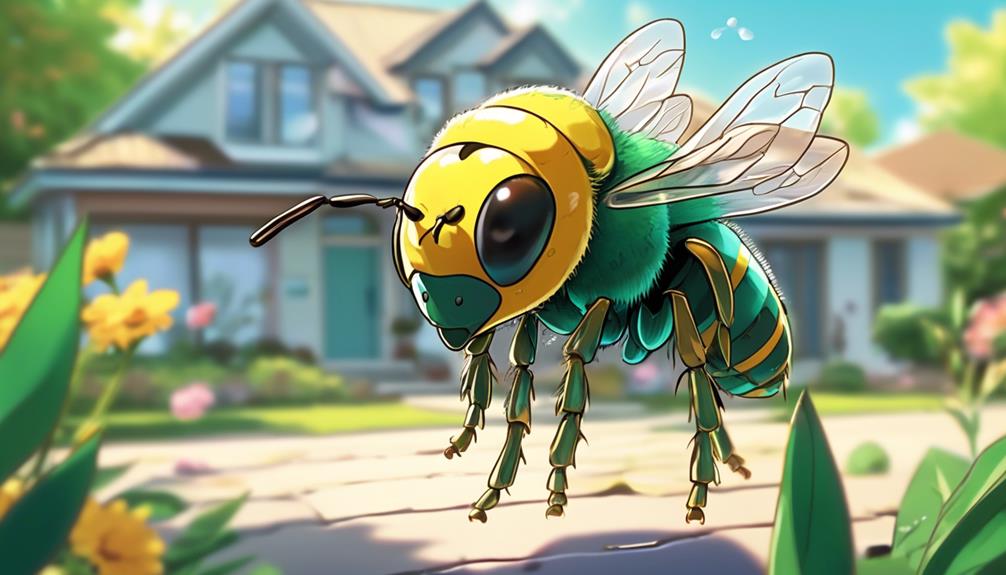Learn exciting ways to banish sweat bees from your home and garden, with professional and natural remedies, in this must-read guide.

How to Get Rid of Sweat Bees Around House
Sweat bees swarming your garden, buzzing around your patio, even sneaking into your home – it's more than just a nuisance, it's a problem you're looking to solve. You're not alone. Many homeowners find themselves in a constant battle with these tiny, yet persistent, insects.
But what if there was a way to not only repel these pesky invaders, but also prevent them from coming back? In the following discussion, we will explore various strategies, both natural and professional, to effectively deal with sweat bees.
So stick around, because you're about to discover how to reclaim your home from these unwelcome guests.
Key Takeaways
- Sweat bees are attracted to human sweat, flowering plants, and bare, sandy soil.
- Natural repellents like bee-deterrent herbs, essential oils mixed with water, and vinegar can help repel sweat bees.
- DIY traps using a plastic bottle, sugary liquid, and dish soap can be an effective and affordable solution to control sweat bee populations.
- If DIY methods fail, professional pest control services can provide thorough inspections and long-term solutions for eliminating sweat bees around the house.
Understanding Sweat Bee Behavior

Diving into the world of sweat bees, it's crucial you recognize their behavior to effectively manage them around your home. These tiny, metallic-colored insects are attracted to human perspiration, hence their name. They're not aggressive by nature, but if you swat them away, they're likely to sting. So, instead of swatting, try to stay calm and let them fly away on their own.
Understanding their nesting habits can also be beneficial. Most sweat bees dig burrows in the ground, often in bare, dry soil. They're solitary creatures, and each female bee tends to her own nest. However, some species of sweat bees are semi-social and may share a nest.
Additionally, sweat bees are pollinators and play a crucial role in our ecosystem. They're attracted to flowers and plants, so if you've got a garden, you might see them buzzing around. But remember, they're more interested in your blooms than you!
Common Sweat Bee Attractants

While understanding sweat bee behavior is vital, it's equally important to know what draws them to your home in the first place. These tiny insects are attracted to specific environmental conditions and substances that, unbeknownst to you, your home and yard might be providing.
Firstly, sweat bees, as their name suggests, are attracted to human sweat. They crave the salts and proteins that our sweat provides. So, if you're outside exercising or working in the yard on a hot day, you're a walking, talking sweat bee magnet.
Secondly, these bees are also drawn to flowering plants. Your beautiful garden may be a feast for your eyes but it's also a feast for sweat bees. They feed on nectar and pollen and are particularly attracted to brightly colored flowers.
Lastly, sweat bees are attracted to bare, sandy soil where they can easily dig and create their nests. If your yard has patches of such soil, it's like rolling out the welcome mat for these bees.
To recap, the top sweat bee attractants are:
- Human sweat
- Flowering plants
- Bare, sandy soil
Natural Sweat Bee Repellents

To keep sweat bees at bay, let's explore some natural repellents that you can use around your home and yard. Natural repellents are a great way to deter these pesky insects without resorting to harmful chemicals.
Firstly, consider planting bee-deterrent herbs. Mint, basil, and citronella are all known to repel sweat bees. You can plant them in your garden, or place pots near windows and doors.
Secondly, try making your own sweat bee spray with essential oils. A mix of peppermint, lemongrass, and citronella oils mixed with water can work wonders. Spray it around your house, particularly in areas where you've seen sweat bees.
Another effective natural repellent is vinegar. Sweat bees dislike its strong scent and acidity. Fill a spray bottle with vinegar and use it on surfaces where sweat bees are likely to land.
DIY Sweat Bee Traps

Often, you'll find that making your own sweat bee traps is an effective and economical solution for dealing with these pesky insects. You don't need fancy tools or expensive materials to craft these traps; common household items will do the trick.
The first step is to gather your materials. Here's a simple list to start with:
- A plastic bottle (a soda bottle will do just fine)
- Some sugary liquid like soda or fruit juice
- Dish soap
Next, you're going to cut the top part of the bottle off and invert it, creating a funnel into the body of the bottle. This is where the bees will enter.
Fill the bottle with the sugary liquid and a few drops of dish soap. The sweetness attracts the bees, while the soap breaks the surface tension of the liquid, causing the bees to sink and drown.
Professional Pest Control Options

If DIY methods aren't doing the trick, you might want to consider professional pest control options. Employing a professional pest controller can be an efficient and effective solution to your sweat bee problem. They're equipped with the right tools, chemicals, and expertise to eliminate these buzzing menaces from your property.
One professional option you may want to consider is a pest management company. They'll conduct a thorough inspection of your home and yard, identify the source of the sweat bee infestation, and formulate a strategic plan to eradicate them. They'll also provide you with preventive measures to keep these pesky insects at bay in the future.
Another option is a local exterminator. They're often more affordable and can provide a quick solution to your problem. However, ensure they've experience in handling sweat bees because their methods can differ from those used for other pests.
Conclusion
So, you've got the scoop on sweat bees! You understand their behavior, know what draws them in, and have tricks to send them packing.
Whether you're using natural repellents, setting up DIY traps, or calling in the pros, you're well-equipped to deal with these pesky intruders.
Don't let sweat bees buzz around your home uninvited. Stand your ground and reclaim your space. Remember, it's your home, not theirs.



